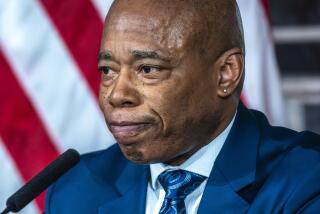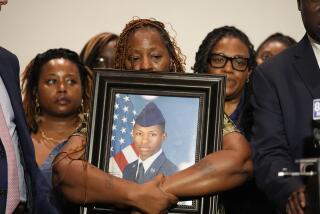Fatal New York police shooting stokes new criticism
- Share via
Reporting from New York — It was what they call a “vertical patrol,” the kind of police activity that generally falls to rookie cops assigned to scour the city’s high-rise housing projects from rooftop to basement, including the often poorly lit stairwells.
The patrol on Thursday night was no different than most until a door swung open into the pitch-black seventh-floor stairwell, just as two uniformed officers began heading down the stairs from the eighth floor. An officer fired a shot. A 28-year-old man fell, mortally wounded.
It would have been tragic and, many say, unforgivable at any time. But this shooting in Brooklyn carries far greater weight in light of the tension brewing over two other recent police killings: one in Ferguson, Mo., in August, and one in the New York City borough of Staten Island in July. Like Michael Brown in Ferguson and Eric Garner in Staten Island, the latest victim, Akai Gurley, was an unarmed black man, and reaction to his death has been swift.
Activists and Gurley’s relatives pointed to the shooting as another example of all that is wrong with policing, whether in Ferguson or New York, while officials here, including Police Commissioner William J. Bratton and Mayor Bill de Blasio, rushed into damage control.
“What happened in Ferguson is different than what happened on Staten Island, and is different than what happened in Brooklyn,” De Blasio said Friday. “This appears to be a tragic mistake. We need to know a lot more, but I don’t think it’s necessarily right to connect all the dots and say, oh, all these things are of the exact same piece.”
To those viewing it from the opposite side, though, Gurley’s death cannot be labeled a tragic accident. They say it highlights the problem of how police view residents of the often crime-ridden areas they patrol, and how their approach sets the stage for tragedies.
“We cannot say a dimly lit stairway is a reason to justify this crime,” said City Councilwoman Vanessa Gibson, an African American who chairs the city’s Public Safety Committee. “I’m reminded once again of the fact that we still have so much to do when you talk about reform, when you talk about cultural shift at the New York Police Department.”
At a rally Saturday hosted by the Rev. Al Sharpton’s National Action Network, speakers invoked the names of others who have died after encounters with New York police. They mentioned Garner, a 43-year-old who was put in an apparently illegal chokehold by an officer who accused him of illicitly selling cigarettes on the sidewalk. A grand jury is weighing whether to indict the officer.
They also mentioned Timothy Stansbury, who was 19 and unarmed when a police officer shot him to death in a Brooklyn housing project in 2004.
Like Gurley, Stansbury was shot in a stairwell by an officer who came upon him while conducting a vertical patrol.
Jonathan Moore, a civil rights attorney representing Garner’s family, said vertical patrols have long been viewed as a problem by community leaders. “You have officers walking down stairways with their guns drawn, and that’s a recipe for disaster,” he said.
Bratton called vertical patrols an essential part of policing, and he said many people welcome them as a means of preventing criminals from taking over their buildings’ rooftops and stairwells. He said the officer involved in Gurley’s shooting, rookie Peter Liang, 27, was part of a “violence reduction” detail assigned to the sprawling Louis H. Pink Houses complex in response to a surge in crime there.
In the last year, Bratton said there had been two homicides in the development. Two robberies and four assaults were reported there in the last month, he told reporters. “What we were doing here was basically putting cops on the dots, attempting to put officers into an environment in which we had recently seen an uptick in violence,” Bratton said.
The lights were out in the stairwell, which Bratton called “pitch black,” when Liang and his partner, also a rookie, entered it. For safety, he said, Liang had his weapon drawn, along with his flashlight.
Gurley, described by Bratton as “a complete innocent,” and a female companion were entering the stairwell at the same time because they had gotten impatient waiting on the seventh floor for an elevator.
The Pink Houses, as they are known, consist of 22 brick, 8-story buildings housing about 4,000 people, according to the city’s Housing Authority. They overlook a busy boulevard in the Brooklyn neighborhood of East New York, one of the city’s highest crime areas. So far this year, there have been 13 homicides in the precinct that includes the Pink Houses.
About a mile away is another housing project where in June, a man stabbed to death a 6-year-old boy and critically wounded his 7-year-old playmate in an elevator. That case prompted demands for better security in public housing because there were no surveillance cameras where the children were attacked. It was several days before a suspect was captured.
Gurley’s shooting shows that security measures remain lax, said residents and community leaders. Having nervous rookies on patrol heightens the danger, they said.
“Something is wrong when you have to walk into a dark stairwell just to go downstairs and then end up losing your life,” said Iesha Sekou, an activist who spoke at Saturday’s rally.
Sharpton demanded that Bratton move quickly to impose rules that would require a senior officer to work alongside a rookie during certain patrols.
“Why would you put two rookies together in a dark alley with a gun and a safety off and the gun out?” Sharpton asked. “I mean, why would you even risk the possibility?”
Twitter: @TinaSusman
More to Read
Sign up for Essential California
The most important California stories and recommendations in your inbox every morning.
You may occasionally receive promotional content from the Los Angeles Times.














